Seminar
Genetic Algorithm LQG & Neural Networks for Gust Load Alleviation of Flying Wings |
| 1 December 2023, Friday, 2:00 - 2:30pm | Speaker: Mr. Elijah Ang Hao Wei, Research Assistant, Department of Mechanical Engineering, NUS |
| Venue: Seminar Room 8D-1, Level 8, Temasek Laboratories | Event Organiser Host: Dr. Huang Xin |
|
ABSTRACT |
The key performance indicators of unmanned aerial vehicles (UAVs) are the range and endurance, which require lightweight and aerodynamically efficient design. Hence, UAVs have increasingly adopted high aspect wings utilizing lightweight and flexible materials. These design choices often result in increased susceptibility to aeroelastic instabilities and gust loads. For flying wing configurations without a tail, oscillations of the rigid-body modes become prevalent, and are strongly coupled with the wing’s elastic modes during flutter. This phenomenon is known as body-freedom flutter (BFF), and it significantly reduces the stability margins of the UAV. In this study, a linear quadratic gaussian (LQG) controller and an artificial neural network (ANN) controller are implemented for gust load alleviation (GLA) and flutter suppression of a lightweight flying wing UAV undergoing body-freedom oscillations. A state-space aeroelastic model has been formulated by coupling the unsteady vortex lattice method for aerodynamics with finite-element based structural dynamics. Open-loop simulations show that the flying wing experiences significant changes in rigid body displacements, together with wingtip bending displacements during gusts. Genetic algorithms are used to optimize the weights of both the LQG and the ANN controller. Results show that both controllers are adequate in reducing the load of the flying wing due to discrete and continuous gusts, and at the same time, enhancing the stability margins of the flying wing. |
| ABOUT THE SPEAKER |
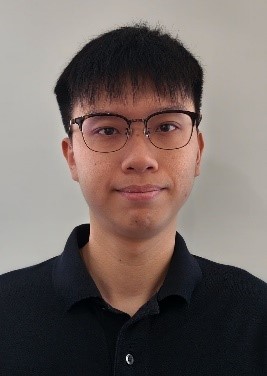
Elijah Ang is currently a research assistant in National University of Singapore, and also a PhD student from Nanyang Technological University, Singapore and currently waiting to defend his thesis. He received his B.Eng in Aerospace Engineering from Nanyang Technological University in 2019. His research interests include numerical and experimental aeroelasticity, unmanned aerial vehicles and machine learning for engineering applications. |

Using Low-fidelity Data in Modelling of Airfoil Aerodynamics |
| 1 December 2023, Friday, 2:30 - 3:00pm | Speaker: Mr. Benjamin Wong Yoong Jia, Associate Scientist, TL@NUS |
| Venue: Seminar Room 8D-1, Level 8, Temasek Laboratories | Event Organiser Host: Dr. Huang Xin |
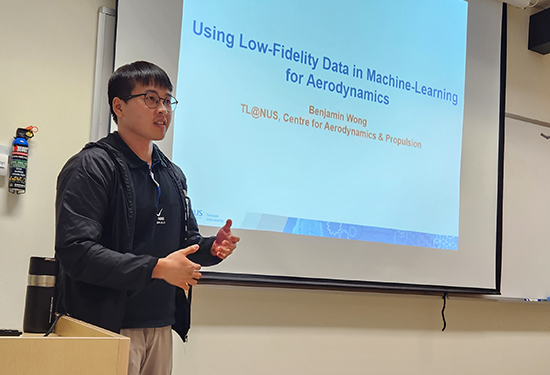
ABSTRACT |
Building accurate and generalizable machine learning models require large training datasets. In aerodynamics applications, the acquisition of large, high-fidelity datasets from CFD or experiments can be expensive. In this sharing, we consider the utilization of low-fidelity data sources to alleviate the reliance on these expensive datasets through (1) incorporation of flow governing equations, (2) application of transfer-learning concepts. While the current work mainly explores the use in surrogate modelling of airfoil aerodynamics, potential future use cases will be shared as well. |
| ABOUT THE SPEAKER |
|
|

A Vision-Only Relative Distance Calculation Method for Multi-UAV Systems |
| 1 December 2023, Friday, 3:00 - 3:30pm | Speaker: Mr. Xu Xiangpeng, PhD Student, Sun Yat-sen University, Shenzhen, China |
| Venue: Seminar Room 8D-1, Level 8, Temasek Laboratories | Event Organiser Host: Dr. Huang Xin |
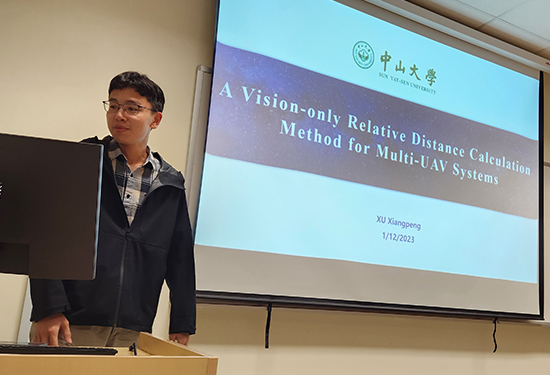
ABSTRACT |
Multiple unmanned aerial vehicles (multi-UAV) systems have been applied in many scenes to improve the flexibility and effectiveness of specific tasks. To reduce dependence on wireless communication and enhance stability during cooperative control of systems, a vision-only and universal metho for relative distance calculating is presented in this paper. First, key components of the UAV were detected by a two-step method. Then, a novel feature encoding method was presented to establish the 2D-3D correspondence with the known 3D structure of UAVs and solve the Perspective-n-Point (PnP) problem. To mitigate misdetections in air-to-air scenarios, a robust auto-weighting Levenberg-Marquardt (AWLM) algorithm was integrated into pose estimation. Flight experiments of a two-UAV system in wireless-denied environments have been conducted to verify the performance of the proposed approach. The results show that the calculation error is less than 8 meters at a relative distance of up to 160 meters at the speed of 45.94 ms per frame, which means the highest precision and fastest processing speed among several similar methods. Besides, the AWLM algorithm exhibits superiority over other optimization methods with fewer outliers (below 0.67%) and a smaller error bound (2.899 meters). |
| ABOUT THE SPEAKER |
|
|

Gas-Liquid Flow Instability Mechanism in the Micropump |
| 1 December 2023, Friday, 3:30 - 4:00pm | Speaker: Mr. Ren Zhipeng (任志鹏), Doctoral candidate, School of Energy Science & Engineering, Harbin Institute of Technology, Harbin |
| Venue: Seminar Room 8D-1, Level 8, Temasek Laboratories | Event Organiser Host: Dr. Huang Xin |
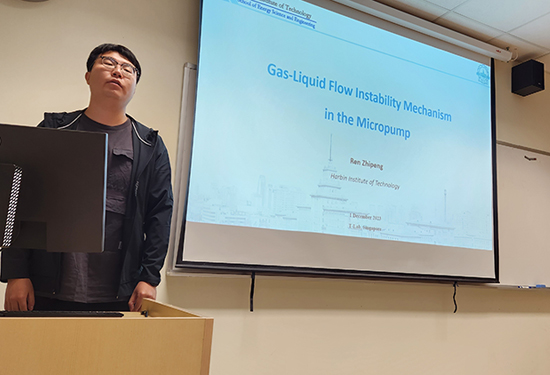
ABSTRACT |
As the vital power and the energy management systems for satellite life extension, the on-orbit refuelling system pressurizes the gas-containing propellants via the micropump, where the mixed transportation involves gas-liquid transitions and hydrodynamic oscillation. This study investigated the spatial-temporal evolution mechanism of gas-liquid mass transfer under synergetic gaseous and vapour cavitating effects in a micropump. The synergetic gaseous and vapour cavitating calculations were achieved for the first time by employing the multiphase mixture model, and the multifactor instabilities induced by four dynamic mass-transfer processes including absorption, evaporation, evolution and condensation were investigated. The results show that the dissolved concentration and the volume fraction are considered to be strongly related to the mass transfer rate, and the effect of turbulence kinetic energy cannot be ignored particularly in impeller and volute. Based on this, the gas-liquid state parameters are focused on unidirectional dissolved and bidirectional released-dissolved conditions. The released gas occupied the head of the suction surface of the long blades and developed downstream, and its presence causes a significant gas increase in downstream. |
| ABOUT THE SPEAKER |
|
|

Research & Application of Deep Learning in Fluids Mechanics |
| 1 December 2023, Friday, 4:00 - 4:30pm | Speaker: Mr. Wang Yaning, CSC PhD Student, Zhejiang University, China |
| Venue: Seminar Room 8D-1, Level 8, Temasek Laboratories | Event Organiser Host: Dr. Huang Xin |
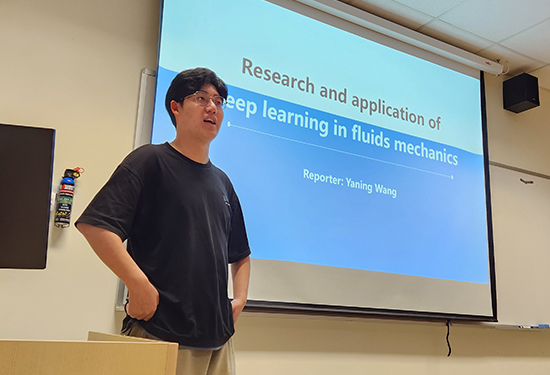
ABSTRACT |
Film cooling is a crucial cooling technique to protect critical components of gas turbines from excessive temperature. Multi-parameter film cooling optimization is still relatively time-consuming due to the overwhelming computational demand from Computational Fluid Dynamics (CFD). To reduce the computational expenses, the present study developed a data-driven framework for predicting and optimizing the film cooling effectiveness of high-pressure turbines based on deep learning. The current framework improved the multi-row film cooling effectiveness with acceptable computational expenses. |
| ABOUT THE SPEAKER |
|
|

Deep-Learning Assisted Reduced Order Model for High-Dimensional Flow Prediction from Sparse Data |
| 1 December 2023, Friday, 4:30 - 5:00pm | Speaker: Mr. Wu Jiaxin, PhD Student, Ocean College, Zhejiang University, Zhoushan, Zhejiang, China |
| Venue: Seminar Room 8D-1, Level 8, Temasek Laboratories | Event Organiser Host: Dr. Huang Xin |

ABSTRACT |
Predicting full-state flow from sparse data are of great scientific and engineering significance yet remain challenging, especially in applications where measurements are few and subjected to noise. To this end, this study proposes a deep-learning assisted non-intrusive reduced order model for high-dimensional flow prediction from sparse data. Based on the compressed sensing and Dynamic Mode Decomposition (DMD), this proposed DCDMD model utilizes deep learning to enhance the conventional convex optimization algorithm, and thus overcomes the strict random distribution condition of sensor locations in conventional studies, eventually allowing flexible sensor deployments and requiring very few sensors. In the studied flow examples, this gray box model shows high physical interpretability, and manifests significant enhancements in accuracy, efficiency, and robustness to data noises. |
| ABOUT THE SPEAKER |
|
|

Research on Cavitation Identification & Suppression Method of Hydrodynamic Torque Converter |
| 1 December 2023, Friday, 5:00 - 5:30pm | Speaker: Mr. Zhang Jiahua, Joint PhD from Beijing Institute of Technology |
| Venue: Seminar Room 8D-1, Level 8, Temasek Laboratories | Event Organiser Host: Dr. Huang Xin |
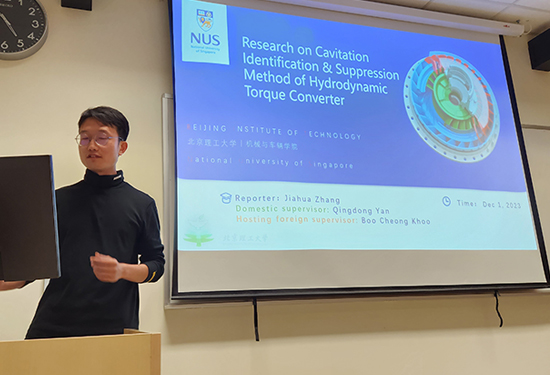
ABSTRACT |
Aiming at the cavitation problem of high-power density hydrodynamic torque converter (HTC), we carry out research on the mapping relationship between blades parameters and cavitation characteristics, cavitation suppression technology of hydrodynamic torque converter, and design technology of low-cavitation impeller system of high-power density HTC. Combined with HTC, multi-physical field and cavitation visualization tests, breakthroughs in the identification and characterization of cavitation characteristics of the HTC and the key technology of multi-objective optimization design of the blades taking cavitation into account, develop a prototype of high power density HTC and carry out the tests of the macroscopic mechanical characteristics and microscopic flow field characteristics, to solve the problem of further increase in the capacity of the torque converter and deterioration of the performance due to the restriction of cavitation, and provide technical support for the design of the integrated transmission system of the high-power-density fluid power machinery. This will provide technical support for the design of high-power density hydro-mechanical comprehensive transmission system. |
| ABOUT THE SPEAKER |
|
|



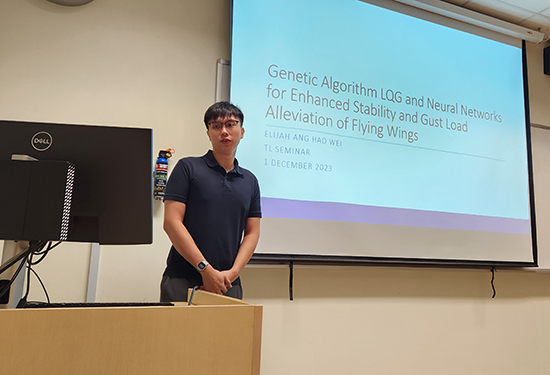
 Benjamin obtained his B.Eng degree (Hons) in Mechanical Engineering from NUS in 2021. After which, he joined TL@NUS as a full-time associate scientist in the Aerodynamics Group and is currently pursuing a PhD in Mechanical Engineering from NUS under the NUS-DSO Graduate Programme.
Benjamin obtained his B.Eng degree (Hons) in Mechanical Engineering from NUS in 2021. After which, he joined TL@NUS as a full-time associate scientist in the Aerodynamics Group and is currently pursuing a PhD in Mechanical Engineering from NUS under the NUS-DSO Graduate Programme.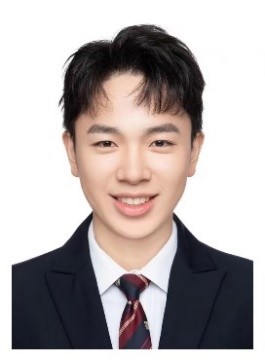 Xu Xiangpeng received the B.S. degree in mathematics and applied mathematics from Sun Yat-sen University, Guangzhou, China, in 2020. He is currently pursuing the Ph.D. degree with the School of Aeronautics and Astronautics, Sun Yat-sen University, Shenzhen, China. His research interests include mutual vision perception and motion measurement in multi-UAV systems.
Xu Xiangpeng received the B.S. degree in mathematics and applied mathematics from Sun Yat-sen University, Guangzhou, China, in 2020. He is currently pursuing the Ph.D. degree with the School of Aeronautics and Astronautics, Sun Yat-sen University, Shenzhen, China. His research interests include mutual vision perception and motion measurement in multi-UAV systems. Ren Zhipeng (任志鹏) is a doctoral candidate of Power Engineering and Engineering Thermophysics, Harbin Institute of Technology (HIT). He received his B.E. and M.E. in Harbin Institute of Technology. His research interests include cavitating flow mechanism and flow instabilities in on-orbit refuelling micropump, liquid oxygen turbopump and rotor turbine flowmeter.
Ren Zhipeng (任志鹏) is a doctoral candidate of Power Engineering and Engineering Thermophysics, Harbin Institute of Technology (HIT). He received his B.E. and M.E. in Harbin Institute of Technology. His research interests include cavitating flow mechanism and flow instabilities in on-orbit refuelling micropump, liquid oxygen turbopump and rotor turbine flowmeter. Wang Yaning is working on his doctorate in Computational Fluids Dynamics (CFD) in Zhejiang University and graduated from Xi’an JiaoTong University in 2019 with a bachelor's degree in mechanical engineering. His major is machine learning for CFD. He enjoys using his skills to contribute to introduce machine learning technology to solve the problems in CFD, such as film cooling prediction and optimization, film cooling passive flow control and etc.
Wang Yaning is working on his doctorate in Computational Fluids Dynamics (CFD) in Zhejiang University and graduated from Xi’an JiaoTong University in 2019 with a bachelor's degree in mechanical engineering. His major is machine learning for CFD. He enjoys using his skills to contribute to introduce machine learning technology to solve the problems in CFD, such as film cooling prediction and optimization, film cooling passive flow control and etc. Wu Jiaxin achieved his bachelor degree at Changsha University of Science and Technology, majoring in coastal and harbor engineering. He achieved master degree in hydraulic engineering from Prof. Lin Pengzhi at Sichuan University, conducting the Numerical Modeling and Investigation of Pollutants Transportation in Mountain Rivers. Now he is a 3rd year PhD student majoring in oceanic technology and engineering, at Ocean College, Zhejiang University, under the supervision of Prof. Luo Min. His PhD thesis topic is Deep-learning Enhanced Reduced Order Model for Complex Dynamical Systems, the research interests include Computational Fluid Dynamics (CFD), deep learning, reduced order modeling (ROM), nonlinear system prediction and control, and compressed sensing.
Wu Jiaxin achieved his bachelor degree at Changsha University of Science and Technology, majoring in coastal and harbor engineering. He achieved master degree in hydraulic engineering from Prof. Lin Pengzhi at Sichuan University, conducting the Numerical Modeling and Investigation of Pollutants Transportation in Mountain Rivers. Now he is a 3rd year PhD student majoring in oceanic technology and engineering, at Ocean College, Zhejiang University, under the supervision of Prof. Luo Min. His PhD thesis topic is Deep-learning Enhanced Reduced Order Model for Complex Dynamical Systems, the research interests include Computational Fluid Dynamics (CFD), deep learning, reduced order modeling (ROM), nonlinear system prediction and control, and compressed sensing.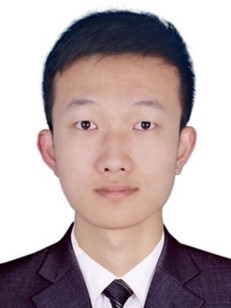 I am Zhang Jiahua, a PhD candidate from School of Mechanical Engineering in Beijing Institute of Technology (BIT, http://www.bit.edu.cn/), Beijing, P. R. China, supervised by Prof. Yan Qingdong & Associate Prof. Liu Cheng. Hosting foreign supervised by Prof. Khoo Boo Cheong. My major research interests include the design and analysis of hydrodynamic components, CFD and cavitation flow.
I am Zhang Jiahua, a PhD candidate from School of Mechanical Engineering in Beijing Institute of Technology (BIT, http://www.bit.edu.cn/), Beijing, P. R. China, supervised by Prof. Yan Qingdong & Associate Prof. Liu Cheng. Hosting foreign supervised by Prof. Khoo Boo Cheong. My major research interests include the design and analysis of hydrodynamic components, CFD and cavitation flow.